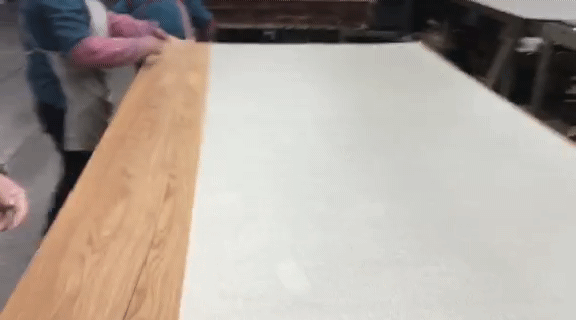The veneer will be slashed from 0.1mm to 2mm. The freshly cut thinner veneer will go through a process call Kiln Dry to stabilise the veneer for lamination on the surface of the board later. Certain moisture must be retained, as later, they will go through hot press process. During the kiln dry process, if the veneer is too dry, visible joints or cracks will be seen after the hot press process. However, this will only apply if you are laminating thin veneer.
For the thicker veneer like 0.35mm and above, they will be adequately kiln dried at a longer time. The factory will then laminate the thicker veneer using a machine that looks like a sewing machine. You must join them together first into desired sizes, before sending the sheet to a hot press process. After all these processes, then you will have your beautiful Natural veneer board. You can use them to make furniture, wall decoration and many more things.
Reconstituted veneer, on the other hand, have the similar process, just that instead of using veneer sliced down from natural log, they are made of compressing softwood trees trunk and the process involves dyeing the compressed wood making them into a log shape for easy slicing. Different mould will be used for different grain design. Few colours of dyes will be used at the same time to achieve the natural look of wood. Other than that, the slicing, kiln drying and lamination process is similar to natural veneer.
Natural veneer will have the natural characteristics of nature. Look around your garden, and I bet you can’t find two trees that look the same. Same goes to Natural veneer. Every log that you slice, you will get different batches of veneer, be it in grain or colour, some even have figures, knots and sugar marks. Even for the same log, as you slice further, the colour and grain will start to change. However, this is the beauty of it. It looks natural, and you can see the pores of the veneer, just like our skin. Natural veneer is also more expensive than Reconstituted veneer. Hardwood trees grow very slowly as compare to softwood trees. So the cost of cutting that tree is much higher. Some of the hardwood trees are getting scarcer to find, and some species are listed endangered in some countries. Reconstituted veneer, on the other hand, will have same grain and color tone for the same batch of production. One log can easily slice about 2600pcs of 600mm x 2440mm or 600mm x 3050mm Reconstituted veneer. With the new technology, some Recon veneer can really look like Natural veneer that is without the natural defects and uneven colour tone.
Both Natural veneer and Reconstituted veneer require varnishing and lacquer to protect them from oxidisation and dirt, regular maintenance and care are needed to prolong their life span.
At Merawood, we have all sort of Natural and Reconstituted veneer or veneered plywood to choose from. All of our Oregon Products have met Green Label standard.

